In recent years, there’s been a shift in the way people think about travel. More and more travelers seek experiences that satisfy their sense of adventure, protect the planet, and benefit local communities.
This growing interest has given rise to a form of travel known as ecotourism.
Ecotourism is a responsible way of traveling, focusing on three main principles: sustainability, conservation, and community involvement.
The goal is to visit beautiful natural areas while minimizing the environmental impact. This means choosing eco-friendly accommodations, supporting local businesses, and respecting wildlife and natural habitats. By doing so, ecotourists help preserve these places for future generations.
As more travelers look for meaningful and environmentally friendly travel experiences, ecotourism continues to grow in popularity.
What is Ecotourism?
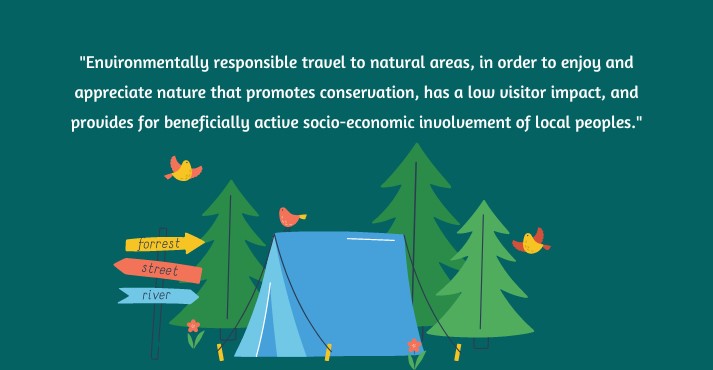
Ecotourism is a form of responsible travel to natural areas that conserves the environment, sustains the well-being of the local people, and involves interpretation and education.
This type of tourism aims to minimize the negative impact on the environment and promote the conservation of biodiversity and cultural heritage.
It is a way for travelers to explore nature while contributing to its preservation and supporting the communities that live in these beautiful places.
Environmental NGOs, such as the International Union for Conservation of Nature (IUCN) and the International Ecotourism Society (TIES), have provided clear definitions and guidelines for sustainable tourism.
The IUCN defines sustainable tourism as
“environmentally responsible travel to natural areas, in order to enjoy and appreciate nature (and accompanying cultural features, both past and present) that promotes conservation, has a low visitor impact, and provides for beneficially active socio-economic involvement of local peoples.”
Similarly, the International Ecotourism Society (TIES) defines ecotourism as
“responsible travel to natural areas that conserves the environment, sustains the well-being of the local people, and involves interpretation and education.”
According to TIES, the fundamental principles of ecotourism include:
- Minimizing physical, social, and behavioral impacts.
- Building environmental and cultural awareness and respect.
- Providing positive experiences for both visitors and hosts.
Ecotourism is about making travel choices that are kind to the environment and beneficial to local communities.
It encourages travelers to be mindful of their impact, respect and appreciate the places they visit, and contribute positively to conserving nature and cultural heritage.
Why is Ecotourism Important?
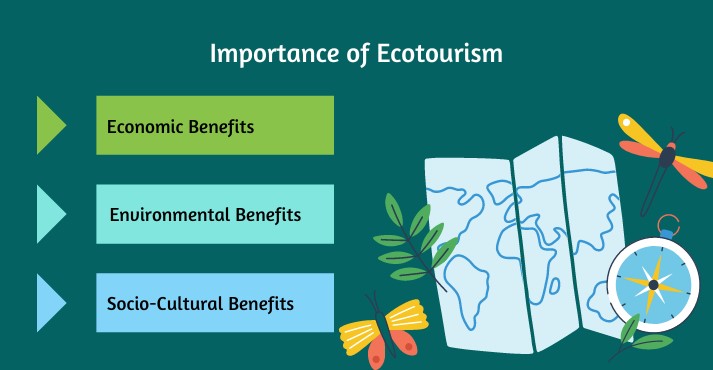
Eco-travel is crucial in promoting sustainable development, particularly in Southeast Asian regions. This form of tourism offers several significant benefits:
1. Economic Benefits
Ecotourism can be a powerful economic engine for local communities. By attracting visitors to natural and cultural sites, it generates income and creates jobs.
For example, in Malaysia’s Sabah region, ecotourism has created numerous employment opportunities in areas such as guiding, hospitality, and conservation projects.
This income helps improve local infrastructure, healthcare, and education, fostering community development.
2. Environmental Benefits
One of ecotourism’s primary goals is to support conservation efforts. By directing tourism revenues towards preserving natural areas and wildlife, ecotourism helps protect ecosystems from degradation.
The Tubbataha Reefs Natural Park is a prime example of this in the Philippines.
The park uses ecotourism fees to fund its conservation efforts, which include protecting endangered marine species and maintaining coral reefs.
This not only safeguards biodiversity but also ensures that future generations can enjoy these areas’ natural beauty.
3. Socio-Cultural Benefits
Eco-travel also promotes the preservation of cultural heritage by encouraging respect and understanding between tourists and local communities. It provides a platform for cultural exchange and helps to sustain traditional practices.
In Indonesia, the village of Tangkahan in North Sumatra has successfully integrated ecotourism into its community.
By offering eco-friendly activities like jungle trekking and river tubing, Tangkahan has become a model for sustainable tourism that respects and preserves the environment and local culture.
Examples of Successful Ecotourism Initiatives
Several ecotourism initiatives in Southeast Asia highlight the positive impact of this approach:
Sepilok Orangutan Rehabilitation Centre, Malaysia
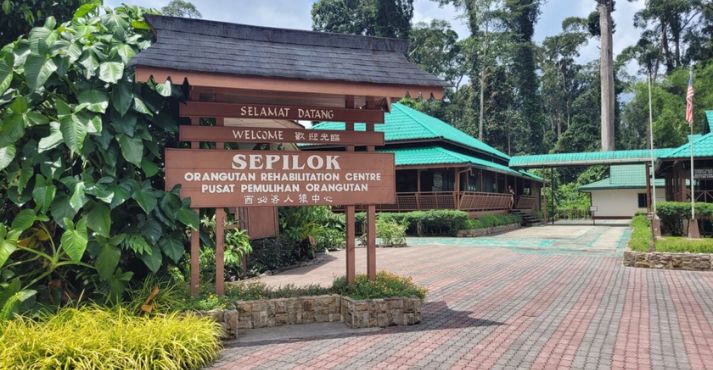
Sepilok Orangutan Rehabilitation Centre, Malaysia
This center rehabilitates orphaned and injured orangutans. Ecotourism plays a vital role in funding its operations, and visitors can learn about conservation efforts while observing these magnificent creatures in their natural habitat.
The center’s success has contributed to the local economy and raised awareness about protecting endangered species.
Komodo National Park, Indonesia
Known for its iconic Komodo dragons, this national park utilizes ecotourism to support conservation and community development.
Tourists contribute to the park’s maintenance through entrance fees, which fund conservation projects and support local villages.
The park’s sustainable tourism model has helped preserve the unique ecosystem while providing economic benefits to the surrounding communities.
Chi Phat, Cambodia
Once a hotspot for illegal logging and hunting, Chi Phat has transformed into a thriving ecotourism destination.
The community-based ecotourism project offers bird watching, mountain biking, and boat tours.
Revenue from tourism supports local conservation efforts and provides alternative livelihoods, reducing the community’s dependence on destructive practices.
Eco-travel is essential for promoting sustainable development in Southeast Asia. Balancing economic growth with environmental and sociocultural preservation creates a harmonious relationship between people and nature.
Successful ecotourism initiatives in the region demonstrate that responsible travel can lead to significant positive impacts, ensuring that natural and cultural treasures are protected and appreciated for future generations.
Environmental Conservation and Biodiversity Protection
Ecotourism is a vital tool for promoting the conservation of natural habitats, wildlife protection, and biodiversity preservation.
By directing attention and resources to the natural world, ecotourism helps safeguard ecosystems.
This sustainable form of travel encourages travelers to appreciate the environment, promoting a greater understanding and respect for nature’s delicate balance.
Promoting Conservation of Natural Habitats
Ecotourism often occurs in pristine, remote areas where natural habitats remain undisturbed.
By attracting tourists to these locations, ecotourism generates funding that can be used to maintain and protect these environments.
For example, national parks and nature reserves often rely on entrance fees and donations from ecotourists to fund conservation projects and protect against illegal activities like logging, poaching, and mining.
In Thailand, the Khao Sok National Park is a prime example. The park offers eco-friendly activities like jungle trekking and canoeing, which draw visitors and generate revenue.
This income supports park rangers and conservation programs to preserve the unique rainforest ecosystem and its inhabitants, including elephants, tigers, and various plant species.
Wildlife Protection
Ecotourism also plays a significant role in wildlife protection. Ecotourism helps protect endangered species and their habitats by creating economic incentives for wildlife conservation.
Wildlife safaris, for instance, allow tourists to observe animals in their natural surroundings, raising awareness about the importance of preserving these species.
In Kenya, the Maasai Mara National Reserve is renowned for its wildlife safaris, particularly the Great Migration of wildebeest.
Ecotourism revenue from these safaris funds anti-poaching patrols and habitat restoration projects, contributing to the protection of numerous species, including lions, elephants, and rhinos.
Biodiversity Preservation
Biodiversity, the variety of life on Earth, is essential for the health of our planet. Ecotourism helps preserve biodiversity by supporting the conservation of diverse ecosystems and promoting sustainable hotel practices.
Nature walks and birdwatching tours are excellent examples of ecotourism activities that highlight the importance of biodiversity.
For instance, Costa Rica is a leader in ecotourism, with its vast array of nature reserves and protected areas.
The Monteverde Cloud Forest Reserve offers guided nature walks and birdwatching tours. Visitors can encounter over 400 species of birds, including the resplendent quetzal.
The fees collected from these activities are reinvested into conservation efforts, ensuring the protection of this biodiversity hotspot.
Ecotourism Activities Contributing to Conservation
- Wildlife Safaris: These provide a non-invasive way to observe animals in their natural habitat, generating funds for conservation while educating tourists about wildlife protection.
- Nature Walks: Guided tours through natural areas raise awareness about conserving these environments and the species that inhabit them.
- Birdwatching Tours: These tours attract bird enthusiasts worldwide, supporting the protection of important bird habitats and promoting biodiversity.
Ecotourism is a practical approach to environmental conservation and biodiversity protection. It ensures that future generations can enjoy our planet’s beauty and diversity.
Sustainable Practices in Ecotourism
Sustainable tourism practices are fundamental to ecotourism principles. They ensure that travel activities have a minimal environmental impact and benefit local communities.
These practices encompass responsible waste management, energy conservation, and water conservation, among other efforts.
Supporting eco-friendly accommodations, tour operators, and local businesses prioritizing sustainability is crucial in promoting responsible travel.
Responsible Waste Management
Effective waste management is a crucial component of sustainable tourism. Ecotourism initiatives often involve measures to reduce, recycle, and properly dispose of waste.
Tourists are encouraged to minimize their use of single-use plastics and to carry reusable items like water bottles and shopping bags.
In many ecotourism destinations, there are strict guidelines for waste disposal to protect natural habitats from pollution.
For instance, in the Galápagos Islands, visitors must adhere to strict regulations to preserve the unique ecosystem. These include packing out all trash, using designated recycling stations, and avoiding plastic packaging.
Eco-friendly tour operators in the region often educate tourists on proper waste management practices to ensure that they contribute to the islands’ conservation efforts.
Energy Conservation
Reducing energy consumption is another important aspect of sustainable tourism.
Eco-friendly accommodations often employ energy-efficient practices such as using renewable energy sources (solar, wind, or hydropower), installing energy-saving appliances, and promoting low-energy lighting.
Travelers are encouraged to conserve energy by turning off lights, unplugging electronics when not in use, and using natural ventilation instead of air conditioning.
One notable example is the El Nido Resorts in the Philippines, which uses solar panels and other renewable energy sources to power its facilities.
It also implements energy-saving measures such as low-energy lighting and energy-efficient appliances, significantly reducing its carbon footprint and promoting sustainability.
Water Conservation
Water conservation is critical in ecotourism, especially in areas with limited water resources. Sustainable practices include using water-saving fixtures, implementing rainwater harvesting systems, and encouraging guests to use water responsibly.
Simple actions, such as taking shorter showers and reusing towels, can significantly affect water conservation efforts.
In Kenya, the Campi ya Kanzi eco-lodge exemplifies water conservation practices. The lodge relies on rainwater harvesting and has implemented water-efficient systems to reduce consumption.
Guests are educated on the importance of conserving water, ensuring that the lodge’s operations do not strain local water resources.
Supporting Eco-Friendly Accommodations and Tour Operators
Choosing eco-friendly accommodations and tour operators is essential for promoting sustainable tourism. These businesses prioritize sustainability, from minimizing environmental impact to supporting local communities.
Eco-friendly lodgings might be built with sustainable materials, operate with renewable energy, and offer organic, locally sourced food.
Tour operators can enhance sustainability by organizing activities that respect wildlife, cultural heritage, and the environment.
For example, the EarthCheck-certified Soneva Fushi resort in the Maldives integrates sustainability into every aspect of its operations.
The resort uses solar power, has a comprehensive waste management system, and supports local communities through various initiatives. By choosing such eco-friendly options, travelers can significantly reduce their environmental footprint.
Supporting Local Businesses
Supporting local businesses is another crucial aspect of sustainable tourism.
By dining at local restaurants, purchasing handmade crafts, and using local guides, tourists can help stimulate the local economy and ensure that the benefits of tourism are distributed within the community.
This practice helps preserve local culture and promotes sustainable economic development.
In Thailand, the community-based tourism project in Mae Kampong village offers an excellent example.
Tourists stay with local families, participate in traditional activities, and buy local products. This model ensures that the economic benefits of tourism support the entire community, fostering sustainability.
By making conscious travel choices and supporting sustainable initiatives, tourists can help ensure that the natural and cultural wonders of the world are preserved for future generations to enjoy.
Responsible Travel Tips for Eco-Conscious Travelers
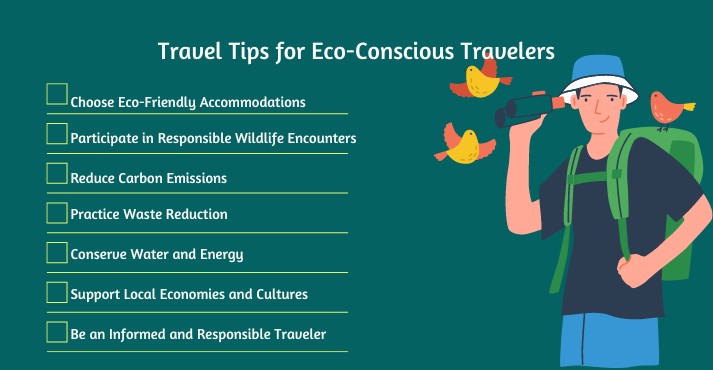
Traveling responsibly and minimizing your environmental impact can be a rewarding and meaningful way to explore the world.
Here are some practical tips for eco-conscious travelers to help you make sustainable choices and support responsible tourism practices.
1. Choose Eco-Friendly Accommodations
- Research and Select Green Certified Hotels: Look for accommodations with certifications like LEED, Green Key, or EarthCheck, which indicate adherence to sustainable practices.
- Stay in Eco-Lodges or Green Hotels: These establishments often use eco-friendly hotel ideas such as renewable energy sources, implement water and energy conservation measures, and support local communities.
- Ask About Sustainability Practices: Before booking, inquire about the hotel’s sustainability policies, such as waste management, energy use, and community involvement.
- Opt for Smaller, Locally Owned Accommodations: Staying in locally owned guesthouses or B&Bs can reduce your carbon footprint and support the local economy.
2. Participate in Responsible Wildlife Encounters
- Choose Ethical Wildlife Tours: Select tour operators prioritizing animal welfare and conservation. Avoid attractions that exploit animals, such as those offering elephant rides or photo ops with captive wildlife.
- Observe Animals in Their Natural Habitat: Engage in activities like wildlife safaris, birdwatching, or marine tours that allow you to see animals in their natural environment without disturbing them.
- Follow Guidelines and Respect Wildlife: To minimize your impact on wildlife, keep a safe distance, avoid feeding animals, and adhere to guidelines provided by guides or park authorities.
- Support Conservation Efforts: Choose tours that contribute to conservation programs or donate some of their profits to wildlife protection initiatives.
3. Reduce Carbon Emissions
- Choose Sustainable Transportation: To reduce your carbon footprint, use public transport, carpool, or rent hybrid/electric vehicles. For short distances, consider walking or cycling.
- Offset Your Carbon Emissions: Calculate your travel emissions and invest in carbon offset programs that support renewable energy projects, reforestation, or other environmental initiatives.
- Fly Less, Stay Longer: Opt for fewer flights by choosing closer destinations or extending your stay in one location rather than hopping between multiple places.
- Travel by Train or Bus: For regional travel, trains and buses are often more environmentally friendly alternatives to flying.
4. Practice Waste Reduction
- Bring Reusable Items: To minimize single-use plastic waste, pack a reusable water bottle, shopping bag, and travel utensils.
- Avoid Plastic Packaging: Choose products with minimal or eco-friendly packaging and avoid plastic straws, bags, and containers.
- Properly Dispose of Waste: Follow local recycling and waste disposal guidelines and, if possible, participate in clean-up efforts.
5. Conserve Water and Energy
- Take Shorter Showers: Reduce water consumption by limiting shower time and reusing towels.
- Use Water-Efficient Toilets: Opt for accommodations with water-efficient fixtures or composting toilets.
- Turn Off Lights and Electronics: Conserve energy by turning off lights and air conditioning and unplugging devices when not in use.
- Use Renewable Energy Sources: Whenever possible, stay in accommodations that utilize solar, wind, or other renewable energy sources.
6. Support Local Economies and Cultures
- Buy Local Products: Purchase souvenirs, crafts, and goods made by local artisans to support the local economy and reduce the carbon footprint associated with imported goods.
- Eat at Local Restaurants: Choose locally-owned restaurants and cafes that use locally sourced ingredients, reducing food miles and supporting the local food industry.
- Respect Local Customs and Traditions: Learn about and respect the customs, traditions, and etiquette of the places you visit, fostering positive interactions and cultural exchange.
- Participate in Community-Based Tourism: Engage in tourism activities that directly benefit local communities, such as homestays, local tours, and cultural workshops.
7. Be an Informed and Responsible Traveler
- Educate Yourself: Learn about the environmental and social issues affecting your destination and how you can help address them through responsible travel choices.
- Spread Awareness: Share your experiences and knowledge about sustainable travel with others to inspire more people to adopt eco-friendly travel practices.
- Leave No Trace: Follow the principles of Leave No Trace, which include disposing of waste properly, respecting wildlife, and leaving natural and cultural sites as you find them.
- Support Sustainable Tourism Initiatives: Choose travel companies and organizations committed to sustainability and ethical practices.
By following these tips, you can reduce your environmental impact, support local communities, and contribute to the preservation of the natural and cultural treasures that make traveling so enriching.
Examples of Ecotourism in Southeast Asia
Southeast Asia is renowned for its rich biodiversity and stunning natural landscapes, making it an ideal destination for ecotourism.
Here are some notable ecotourism destinations in the region. Each offers unique experiences emphasizing sustainability, conservation, and community involvement.
1. Kinabalu Park, Malaysia
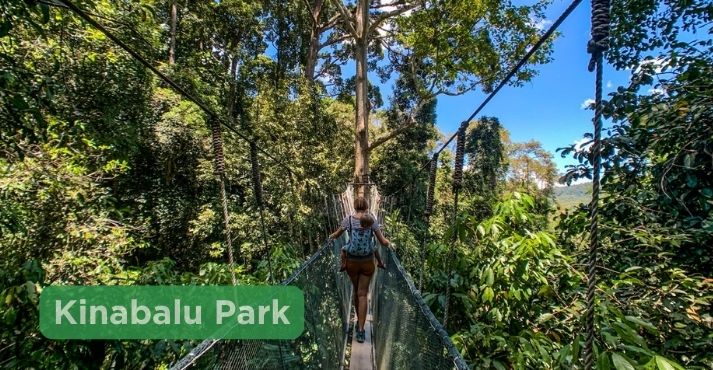
Kinabalu Park is a UNESCO World Heritage Site in Sabah, Malaysia. This park is home to Mount Kinabalu, the highest peak in Southeast Asia.
It boasts diverse flora and fauna, including many endemic species. Ecotourism activities in Kinabalu Park include guided nature walks, birdwatching, and mountain climbing.
The park’s management focuses on conservation and environmental education, ensuring that tourism activities do not harm the ecosystem.
2. Taman Negara National Park, Malaysia
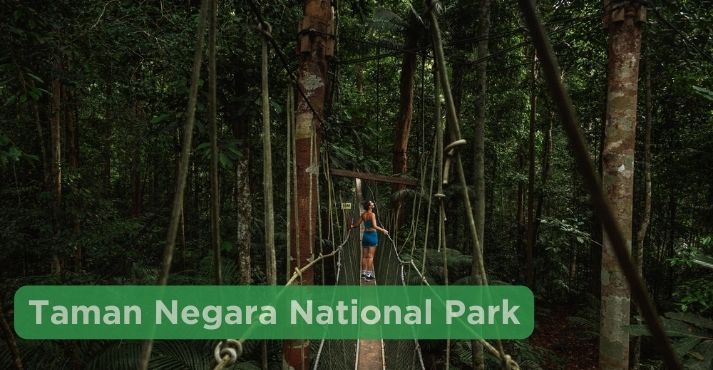
Taman Negara National Park is one of the oldest rainforests in the world, and visitors can experience its ancient ecosystems.
The park is in Peninsular Malaysia and features canopy walkways, jungle trekking, river cruises, and wildlife spotting.
Ecotourism initiatives in Taman Negara aim to protect its biodiversity while supporting the local Orang Asli communities through eco-friendly tourism activities.
3. Khao Sok National Park, Thailand
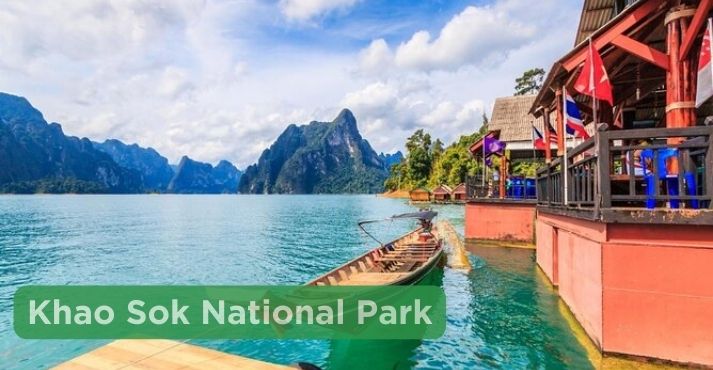
Khao Sok National Park in southern Thailand is famous for its dramatic limestone karsts, lush rainforests, and the artificial Cheow Lan Lake.
Visitors can enjoy jungle trekking, canoeing, and wildlife safaris.
The park is home to diverse wildlife, including elephants, tigers, and gibbons. Ecotourism in Khao Sok emphasizes low-impact activities and supports local conservation efforts.
4. Tubbataha Reefs Natural Park, Philippines
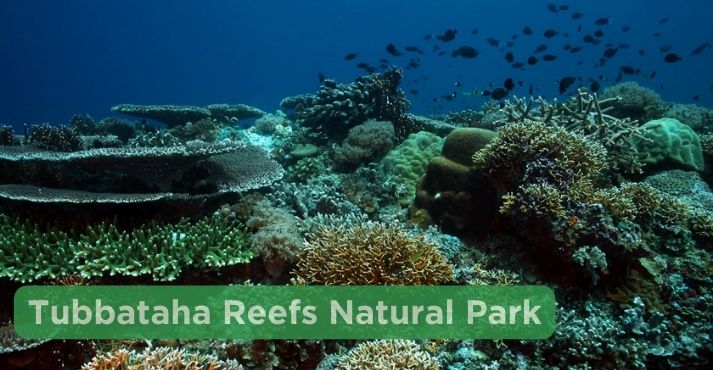
Tubbataha Reefs Natural Park, a UNESCO World Heritage Site, is located in the Sulu Sea of the Philippines.
This marine park is renowned for its rich coral reefs and abundant marine life, making it a top destination for diving enthusiasts.
Strict regulations and ecotourism fees help fund conservation efforts, protecting the park’s unique underwater ecosystems.
Diving trips are carefully managed to minimize environmental impact and support sustainable tourism.
5. Komodo National Park, Indonesia

Komodo National Park, another UNESCO World Heritage Site, is famous for its iconic dragons.
Located in Indonesia, the park has a stunning archipelago (island group) with diverse marine and terrestrial ecosystems.
Visitors can enjoy activities such as guided tours to see the Komodo dragons, snorkeling, and diving in the park’s vibrant coral reefs.
The park’s ecotourism model promotes conservation and supports local communities through sustainable tourism practices.
6. Mergui Archipelago, Myanmar
The Mergui Archipelago in Myanmar consists of over 800 islands, many of which remain unexplored.
This remote destination offers pristine beaches, crystal-clear waters, and diverse marine life.
Ecotourism activities include snorkeling, diving, and sea kayaking.
Efforts are being made to develop sustainable tourism that protects the archipelago’s natural beauty and benefits the local Moken communities.
7. Cat Tien National Park, Vietnam
Cat Tien National Park in southern Vietnam is a haven for wildlife enthusiasts. The park is home to various species, including primates, elephants, and endangered birds.
Ecotourism activities include guided wildlife tours, birdwatching, and trekking.
Conservation programs in the park focus on protecting its biodiversity and supporting local communities through sustainable tourism initiatives.
By visiting these parks and participating in eco-friendly activities, travelers can enjoy unique experiences while contributing to conservation efforts and supporting local communities.
Challenges and Opportunities in Ecotourism
As the ecotourism concept is still in process and being introduced to travelers on different levels, it comes with its unique challenges and opportunities. Let’s take a look at them in detail.
Challenges in Ecotourism
Here are some common challenges travelers and destinations face while implementing the best ecotourism strategies.
1. Overtourism
One of the most significant challenges facing ecotourism is over-tourism. When too many tourists visit a destination, it can lead to overcrowding, strain local resources, and diminish the quality of the visitor experience.
Due to the sheer volume of visitors, popular ecotourism spots can suffer from environmental degradation, which can harm wildlife, erode trails, and increase pollution.
For example, areas like Komodo National Park in Indonesia have faced challenges in managing the influx of tourists while protecting the delicate ecosystems and the iconic Komodo dragons.
2. Habitat Degradation
Habitat degradation is another critical issue. Even well-intentioned tourists can inadvertently damage natural habitats.
Activities such as off-trail hiking, improper waste disposal, and the construction of tourist facilities can negatively impact the environment.
In marine areas, coral reefs can suffer from anchor damage, pollution, and unsustainable diving practices.
For instance, the Tubbataha Reefs Natural Park in the Philippines constantly battles the threat of coral damage due to increased diving activities.
3. Inadequate Infrastructure
Many ecotourism destinations are located in remote or underdeveloped areas with insufficient infrastructure to support large numbers of tourists.
This includes a lack of proper waste management systems, inadequate transportation facilities, and insufficient accommodation options that meet sustainable standards.
In places like the Mergui Archipelago in Myanmar, the lack of infrastructure can make it challenging to develop sustainable tourism practices without harming the pristine environment.
Opportunities
The challenges lead to several exciting and new opportunities that can help implement ecotourism concepts and preserve natural landscapes.
1. Collaboration Between Government Agencies
Government agencies play a crucial role in regulating and promoting sustainable tourism practices.
Governments can mitigate the negative impacts of ecotourism by implementing policies and regulations that limit the number of visitors, protect natural areas, and ensure sustainable development.
For example, governments can establish protected areas, enforce strict environmental regulations, and fund conservation projects.
Collaborative efforts between national and local governments, such as Malaysia’s management of Kinabalu Park, can lead to effective conservation and sustainable tourism practices.
2. Involvement of Local Communities
Local communities are essential stakeholders in ecotourism initiatives. Their involvement ensures that tourism benefits are shared and local knowledge and practices are respected.
Community-based tourism projects, where locals manage tourism activities, can create jobs, reduce poverty, and encourage conservation.
For instance, the success of community-based tourism in Mae Kampong village in Thailand highlights how local involvement can lead to sustainable and profitable tourism that benefits both the environment and the community.
3. Support from the Tourism Industry
The tourism industry, including tour operators, hotels, and travel agencies, has a significant role in promoting sustainable practices.
The industry can mitigate tourism’s environmental impacts by adopting eco-friendly policies, providing education on responsible tourism, and investing in conservation projects.
Companies can offer eco-friendly accommodations, promote off-peak travel in shoulder season to reduce over-tourism, and support initiatives that protect natural habitats.
For example, eco-lodges like those in Taman Negara National Park in Malaysia showcase how sustainable practices can be integrated into the hospitality industry.
Conclusion
Ecotourism offers an enriching and sustainable way to explore the world’s natural and cultural wonders.
By understanding ecotourism and implementing its principles, travelers can enjoy unique experiences and contribute positively to the environment and local communities.
From the ancient rainforests of Taman Negara National Park to the vibrant coral reefs of Tubbataha, ecotourism destinations in Southeast Asia showcase the region’s incredible biodiversity and natural beauty.
However, addressing the challenges of over-tourism, habitat degradation, and inadequate infrastructure is crucial to ensure these treasures remain for future generations.
Tourists can mitigate these impacts by supporting eco-friendly accommodations, engaging in responsible wildlife encounters, and practicing sustainable travel habits.















